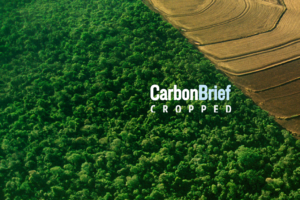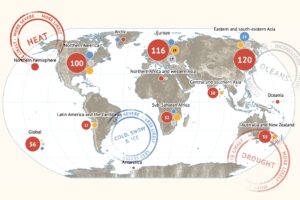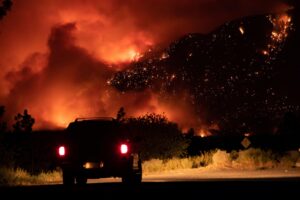Welcome to Carbon Brief’s DeBriefed.
An essential guide to the week’s key developments relating to climate change.
This is an online version of Carbon Brief’s weekly DeBriefed email newsletter. Subscribe for free here.
This week
2023 ‘smashes’ records
RECORD-SHATTERING: 2023 “smashed” the record for the hottest year by a large margin, reported the Guardian. The newspaper said on Tuesday that, according to the EU’s Copernicus Climate Change Service, 2023 was 1.48C hotter than pre-industrial times. This is 0.17C higher than the last record set in 2016 – “marking a very large increase in climate terms”, according to the Guardian. And today the record was confirmed by the UN’s World Meteorological Organization, which has just published the findings of six leading climate datasets.
CHARTING CHANGE: In its coverage of the data, BBC News produced a number of charts and figures illustrating the path of global warming. Its analysis showed that almost every day since July has seen a new global air temperature high for the time of year. Meanwhile, the Independent published a feature examining whether 2024 could be even hotter than 2023.
STATE OF THE CLIMATE: Carbon Brief has just published the last of its quarterly state of the climate updates for 2023. It explains that 2023 was the warmest year “by a large margin”, at between 1.34C and 1.54C above pre-industrial levels across different datasets. Last year was also the warmest on record for ocean heat content, which increased notably between 2022 and 2023.
UK MP quits over fossil fuels
‘TRAGEDY’: The UK’s former energy minister Chris Skidmore quit as an MP in protest at the government’s plans to drill for more oil and gas in the North Sea, the Financial Times reported. In his resignation letter, Skidmore said it was “a tragedy that the UK has been allowed to lose its climate leadership” under prime minister Rishi Sunak, according to the newspaper.
BILL DELAYED: Skidmore quit over the government’s offshore petroleum licensing bill, which aims to “maximise” new oil and gas production, the FT said. The bill was due to be read in the House of Commons this week, but ended up being postponed, the Times reported. BBC News reported that Sir Alok Sharma, the Conservative MP and COP26 president, said he would vote against the bill, calling it “a total distraction” which reinforces the idea the UK is “not serious” about tackling climate change.
Renewables on the rise
RECORD RENEWABLES: A boom in Chinese solar power drove another record-breaking year of renewables growth in 2023, according to a new International Energy Agency (IEA) report covered by Carbon Brief. The world is now on track to build enough solar, wind and other renewables over the next five years to power the equivalent of the US and Canada combined, according to Carbon Brief’s analysis of the findings.
UK SOLAR: Along with the increase in global renewable capacity, there has been continued growth in low-carbon upgrades on UK homes, with solar and heat pumps driving record installations in 2023, according to separate Carbon Brief analysis.
Around the world
- US COAL DROP: US emissions fell by 1.9% in 2023, largely due to coal declining to its lowest level in 50 years, the New York Times reported. By contrast, US oil and gas production is set to hit a record in 2024 and 2025, said the Financial Times.
- ‘A LA CARTE’: Saudi Arabia’s energy minister has claimed that the headline COP28 agreement to transition away from fossil fuels is just one of several “choices” on an “a la carte menu”, reported Climate Home News.
- WAR EMISSIONS: Israel’s assault on Gaza since 7 October has produced more greenhouse gas emissions than 20 of the world’s most climate-vulnerable countries create in a year, according to new analysis covered by the Guardian.
- GERMANY PROTESTS: Farmers took to the streets of Berlin to protest against the German government’s decision to cut agricultural subsidies, Deutsche Welle reported.
- DEEP SEA MINING: Norway has become the first nation to approve commercial deep-sea mining, opening up a vast area of the Arctic to the extractive practice despite warnings from scientists, Mongabay reported.
- OFFSETS CONTROVERSY: The first-ever carbon-offset exchange under a new Paris Agreement mechanism, involving Switzerland buying credits for the rollout of electric buses in Thailand, is facing integrity questions, Climate Home News said.
40%
The proportion of North Sea oil and gas licences in UK waters owned by foreign companies and investors, according to EnergyMonitor.
Latest climate research
- A new research paper in Nature Climate Change presented a “conceptual framework” for considering the role of justice within climate research.
- The presence of urban green space is associated with “significantly lower rates of violent crime committed outside”, according to an International Journal of Biometeorology study conducted in Australia.
- A pair of studies in the Journal of Climate delved into an “exceptional heatwave” in east Antarctica in 2022, which brought “widespread 30-40C temperature anomalies across the ice sheet”.
(For more, see Carbon Brief’s in-depth daily summaries of the top climate news stories on Monday, Tuesday, Wednesday, Thursday and Friday.)
Captured

A record 42 editorials opposing action to tackle climate change were published by UK newspapers in 2023, according to new Carbon Brief analysis. Written almost exclusively by right-leaning papers, these editorials called for delays to UK bans on the sale of fossil fuel-powered cars and boilers, as well as for more oil-and-gas production in the North Sea, according to the findings. In response to such demands, prime minister Rishi Sunak performed a “U-turn” in September on some of his government’s major net-zero policies.
Spotlight
Investigating Antarctica’s colossal icebergs
This week, Carbon Brief speaks to Dr Oliver Marsh, a glaciologist who is principal investigator of a British Antarctic Survey (BAS) mission currently studying iceberg calving events at Antarctica’s Brunt ice shelf (pictured).

Carbon Brief: Can you please explain what fieldwork you are currently working on?
Dr Oliver Marsh: We are drilling ice cores to collect ice samples from the Brunt ice shelf. These will be brought back to Cambridge [where BAS is located] and University College London (UCL) in order to test their physical and chemical properties. We are also setting up seismic and GPS equipment to monitor fracture growth and strain rates on the ice shelf. We will then link the properties of the ice to the behaviour of the fractures.
CB: What do you hope to find out by conducting this fieldwork?
OM: We are interested in the mechanism and timing of crack growth leading to iceberg calving [where chunks of ice break off from the front of a glacier]. In particular, we want to understand how changes in ice properties change calving rates. The ice shelf we are working on has a well-documented history of crack growth, with two large calving events in the last three years, and the new information we gain from precise laboratory measurements will help us to understand how – and under what conditions – fractures occur in the lead-up to these calving events.
CB: What are the biggest hazards with conducting fieldwork on the Brunt ice shelf?
OM: The Brunt ice shelf is a good location to monitor fracture growth due to its dynamic behaviour. This means there are rifts and other cracks in the ice that can be hazardous for travel. These cracks are heavily monitored with a suite of geophysical instruments, including ground-penetrating radar, GPS and satellite data, and precautions are taken when moving around. Fieldwork in Antarctica also has significant hazards associated with the weather, for example, strong winds and wind chill.
CB: How is climate change affecting iceberg calving events in Antarctica?
OM: Calving occurs as a normal process of ice loss from the continent. But, as it occurs in discrete events and very infrequently for some ice shelves, it is difficult to determine whether rates are changing from a short satellite record. Other fracturing processes, such as hydrofracture and ice shelf collapse, are linked to both ocean and atmospheric warming, so it is possible that calving rates may increase in the future.
CB: What would be the implications of accelerated iceberg calving for the climate and ecosystems?
OM: Increased calving is likely to weaken ice shelves that fringe the continent and support the glaciers inland. This can help to speed up glacier flow and ice loss to the ocean, contributing to sea level rise. An increase in the volume of icebergs may also cause issues for ecosystems, particularly in areas where icebergs ground on the ocean floor, blocking foraging routes for penguins and seals, for instance.
Watch, read, listen
IDAI AFTERMATH: An audio documentary from the BBC World Service explored how communities in Beira, Mozambique are still reeling five years after Cyclone Idai.
PEOPLE FIRST: Context spoke to a range of experts about how the deal to transition away from fossil fuels agreed at COP28 can be achieved in a way that prioritises people’s needs.
INFLECTION POINTS: Robinson Meyer, founding editor of the climate publication Heatmap, appeared on the Chris Hayes Podcast to talk about rising fossil fuels and falling low-carbon technology prices.
Coming up
- 13 January: Taiwan presidential and parliamentary elections
- 15-19 January: World Economic Forum, Davos, Switzerland
- 16-19 January: 60th session of the Intergovernmental Panel on Climate Change, Istanbul, Turkey
- 17-18 January: G20 women’s sustainability working group meeting, Vila do Conde, Brazil
Pick of the jobs
- Global Forest Coalition, director | Salary: €32.50 per hour. Location: Remote
- The New York Times, Climate Forward editor | Salary: $170,000-180,000. Location: New York
- Department for Energy Security and Net Zero, deputy director, strategy development | Salary: £75,000. Location: Choice of various UK cities
DeBriefed is edited by Daisy Dunne. Please send any tips or feedback to debriefed@carbonbrief.org
The post DeBriefed 12 January: 2023 ‘smashes’ global heat record; UK MP quits over oil and gas; Studying Antarctica’s mammoth icebergs appeared first on Carbon Brief.
Greenhouse Gases
Cropped 13 August 2025: Fossil-fuelled bird decline; ‘Deadly’ wildfires; Empty nature fund
We handpick and explain the most important stories at the intersection of climate, land, food and nature over the past fortnight.
This is an online version of Carbon Brief’s fortnightly Cropped email newsletter. Subscribe for free here.
Key developments
‘Deadly’ wildfires
WINE BRAKE: France experienced its “largest wildfire in decades”, which scorched more than 16,000 hectares in the country’s southern Aude region, the Associated Press said. “Gusting winds” fanned the flames, Reuters reported, but local winemakers and mayors also “blam[ed] the loss of vineyards”, which can act as a “natural, moisture-filled brake against wildfires”, for the fire’s rapid spread. It added that thousands of hectares of vineyards were removed in Aude over the past year. Meanwhile, thousands of people were evacuated from “deadly” wildfires in Spain, the Guardian said, with blazes ongoing in other parts of Europe.
MAJOR FIRES: Canada is experiencing its second-worst wildfire season on record, CBC News reported. More than 7.3m hectares burned in 2025, “more than double the 10-year average for this time of year”, the broadcaster said. The past three fire seasons were “among the 10 worst on record”, CBC News added. Dr Mike Flannigan from Thompson Rivers University told the Guardian: “This is our new reality…The warmer it gets, the more fires we see.” Elsewhere, the UK is experiencing a record year for wildfires, with more than 40,000 hectares of land burned so far in 2025, according to Carbon Brief.
-
Sign up to Carbon Brief’s free “Cropped” email newsletter. A fortnightly digest of food, land and nature news and views. Sent to your inbox every other Wednesday.
WESTERN US: The US state of Colorado has recorded one of its largest wildfires in history in recent days, the Guardian said. The fire “charred” more than 43,300 hectares of land and led to the temporary evacuation of 179 inmates from a prison, the newspaper said. In California, a fire broke out “during a heatwave” and burned more than 2,000 hectares before it was contained, the Los Angeles Times reported. BBC News noted: “Wildfires have become more frequent in California, with experts citing climate change as a key factor. Hotter, drier conditions have made fire seasons longer and more destructive.”
FIRE FUNDING: “Worsening fires” in the Brazilian Amazon threaten new rainforest funding proposals due to be announced at the COP30 climate summit later this year, experts told Climate Home News. The new initiatives include the Tropical Forests Forever Facility, which the outlet said “aims to generate a flow of international investment to pay countries annually in proportion to their preserved tropical forests”. The outlet added: “If fires in the Amazon continue to worsen in the years to come, eligibility for funding could be jeopardised, Brazil’s environment ministry acknowledged.”
Farming impacts
OUT OF ORBIT: US president Donald Trump moved to “shut down” two space missions which monitor carbon dioxide and plant health, the Associated Press reported. Ending these NASA missions would “potentially shu[t] off an important source of data for scientists, policymakers and farmers”, the outlet said. Dr David Crisp, a retired NASA scientist, said the missions can detect the “glow” of plant growth, which the outlet noted “helps monitor drought and predict food shortages that can lead to civil unrest and famine”.
FARM EXTREMES: Elsewhere, Reuters said that some farmers are considering “abandoning” a “drought-hit” agricultural area in Hungary as “climate change cuts crop yields and reduces groundwater levels”. Scientists warned that rising temperatures and low rainfall threaten the region’s “agricultural viability”, the newswire added. Meanwhile, the Premium Times in Nigeria said that some farmers are “harvest[ing] crops prematurely” due to flooding fears. A community in the south-eastern state of Imo “has endured recurrent floods, which wash away crops and incomes alike” over the past decade, the newspaper noted.
SECURITY RISKS: Food supply chains in the UK face “escalating threats from climate impacts and the migration they are triggering”, according to a report covered by Business Green. The outlet said that £3bn worth of UK food imports originated from the 20 countries “with the highest numbers of climate-driven displacements” in 2024, based on analysis from the Energy and Climate Intelligence Unit. The analysis highlighted that “climate impacts on food imports pose a threat to UK food security”. Elsewhere, an opinion piece in Dialogue Earth explored how the “role of gender equity in food security remains critically unaddressed”.
Spotlight
Fossil-fuelled bird decline
This week, Carbon Brief covers a new study tracing the impact of fossil-fuelled climate change on tropical birds.
Over the past few years, biologists have recorded sharp declines in bird numbers across tropical rainforests – even in areas untouched by humans – with the cause remaining a mystery.
A new study published this week in Nature Ecology and Evolution could help to shed light on this alarming phenomenon.
The research combined ecological and climate attribution techniques for the first time to trace the fingerprint of fossil-fuelled climate change on declining bird populations.
It found that an increase in heat extremes driven by climate change has caused tropical bird populations to decline by 25-38% in the period 1950-2020, when compared to a world without warming.
In their paper, the authors noted that birds in the tropics could be living close to their “thermal limits”.
Study lead author Dr Maximilian Kotz, a climate scientist at the Barcelona Supercomputing Center in Spain, explained to Carbon Brief:
“High temperature extremes can induce direct mortality in bird populations due to hyperthermia and dehydration. Even when they don’t [kill birds immediately], there’s evidence that this can then affect body condition which, in turn, affects breeding behaviour and success.”
Conservation implications
The findings have “potential ramifications” for commonly proposed conservation strategies, such as increasing the amount of land in the tropics that is protected for nature, the authors said. In their paper, they continued:
“While we do not disagree that these strategies are necessary for abating tropical habitat loss…our research shows there is now an additional urgent need to investigate strategies that can allow for the persistence of tropical species that are vulnerable to heat extremes.”
In some parts of the world, scientists and conservationists are looking into how to protect wildlife from more intense and frequent climate extremes, Kotz said.
He referenced one project in Australia which is working to protect threatened wildlife following periods of extreme heat, drought and bushfires.
Prof Alex Pigot, a biodiversity scientist at University College London (UCL), who was not involved in the research, said the findings reinforced the need to systematically monitor the impact of extreme weather on wildlife. He told Carbon Brief:
“We urgently need to develop early warning systems to be able to anticipate in advance where and when extreme heatwaves and droughts are likely to impact populations – and also rapidly scale up our monitoring of species and ecosystems so that we can reliably detect these effects.”
There is further coverage of this research on Carbon Brief’s website.
News and views
EMPTY CALI FUND: A major voluntary fund for biodiversity remains empty more than five months after its launch, Carbon Brief revealed. The Cali Fund, agreed at the COP16 biodiversity negotiations last year, was set up for companies who rely on nature’s resources to share some of their earnings with the countries where many of these resources originate. Big pharmaceutical companies did not take up on opportunities to commit to contributing to the fund or be involved in its launch in February 2025, emails released to Carbon Brief showed. Just one US biotechnology firm has pledged to contribute to the fund in the future.
LOSING HOPE: Western Australia’s Ningaloo reef – long considered a “hope spot” among the country’s coral reefs for evading major bleaching events – is facing its “worst-ever coral bleaching”, Australia’s ABC News reported. The ocean around Ningaloo has been “abnormally” warm since December, resulting in “unprecedented” bleaching and mortality, a research scientist told the outlet. According to marine ecologist Dr Damian Thomson, “up to 50% of the examined coral was dead in May”, the Sydney Morning Herald said. Thomson told the newspaper: “You realise your children are probably never going to see Ningaloo the way you saw it.”
‘DEVASTATION BILL’: Brazil’s president, Luiz Inácio Lula da Silva, signed a “contentious” environmental bill into law, but “partially vetoed” some of the widely criticised elements, the Financial Times reported. Critics, who dubbed it the “devastation bill”, said it “risked fuelling deforestation and would harm Brazil’s ecological credentials” just months before hosting the COP30 climate summit. The newspaper said: “The leftist leader struck down or altered 63 of 400 provisions in the legislation, which was designed to speed up and modernise environmental licensing for new business and infrastructure developments.” The vetoes need to be approved by congress, “where Lula lacks a majority”, the newspaper noted.
RAINFOREST DRILLING: The EU has advised the Democratic Republic of the Congo (DRC) against allowing oil drilling in a vast stretch of rainforest and peatland that was jointly designated a “green corridor” earlier this year, Climate Home News reported. In May, the DRC announced that it planned to open the conservation area for drilling, the publication said. A spokesperson for the European Commission told Climate Home News that the bloc “fully acknowledges and respects the DRC’s sovereign right to utilise its diverse resources for economic development”, but that it “highlights the fact that green alternatives have facilitated the protection of certain areas”.
NEW PLAN FOR WETLANDS: During the 15th meeting of the Ramsar Convention on Wetlands, held in Zimbabwe from 23 to 31 July, countries agreed on the adoption of a new 10-year strategic plan for conserving and sustainably using the world’s wetlands. Down to Earth reported that 13 resolutions were adopted, including “enhancing monitoring and reporting, capacity building and mobilisation of resources”. During the talks, Zimbabwe’s environment minister announced plans to restore 250,000 hectares of degraded wetlands by 2030 and Saudi Arabia entered the Convention on Wetlands. Panamá will host the next COP on wetlands in July 2028.
MEAT MADNESS: DeSmog covered the details of a 2021 public relations document that revealed how the meat industry is trying to “make beef seem climate-friendly”. The industry “may have enlisted environmental groups to persuade people to ‘feel better’ about eating beef”, the outlet said, based on this document. The strategy was created by a communications agency, MHP Group, and addressed to the Global Roundtable for Sustainable Beef. One of the key messages of the plan was to communicate the “growing momentum in the beef industry to protect and nurture the Earth’s natural resources”. MHP Group did not respond to a request for comment, according to DeSmog.
Watch, read, listen
MAKING WAVES: A livestream of deep-sea “crustaceans, sponges and sea cucumbers” has “captivated” people in Argentina, the New York Times outlined.
BAFFLING BIRDS: The Times explored the backstory to the tens of thousands of “exotic-looking” parakeets found in parks across Britain.
PLANT-BASED POWER: In the Conversation, Prof Paul Behrens outlined how switching to a plant-based diet could help the UK meet its climate and health targets.
MARINE DISCRIMINATION: Nature spoke to a US-based graduate student who co-founded Minorities in Shark Science about her experiences of racism and sexism in the research field.
New science
- Applying biochar – a type of charcoal – to soils each year over a long period of time can have “sustained benefits for crop yield and greenhouse gas mitigation”, according to a Proceedings of the National Academy of Sciences study.
- New research, published in PLOS Climate, found that nearly one-third of highly migratory fish species in the US waters of the Atlantic Ocean have “high” or “very high” vulnerability to climate change, but the majority of species have “some level of resilience and adaptability”.
- A study in Communications Earth & Environment found a “notable greening trend” in China’s wetlands over 2000-23, with an increasing amount of carbon being stored in the plants growing there.
In the diary
- 18-29 August: Second meeting of the preparatory commission for the Agreement on Marine Biological Diversity of Areas beyond National Jurisdiction | New York
- 24-28 August: World Water Week | Online and Stockholm, Sweden
- 26-29 August: Sixth forum of ministers and environment authorities of Asia Pacific | Nadi, Fiji
Cropped is researched and written by Dr Giuliana Viglione, Aruna Chandrasekhar, Daisy Dunne, Orla Dwyer and Yanine Quiroz. Please send tips and feedback to cropped@carbonbrief.org
The post Cropped 13 August 2025: Fossil-fuelled bird decline; ‘Deadly’ wildfires; Empty nature fund appeared first on Carbon Brief.
Cropped 13 August 2025: Fossil-fuelled bird decline; ‘Deadly’ wildfires; Empty nature fund
Greenhouse Gases
Holding the line on climate: EPA
CCL submits a formal comment on EPA’s proposed endangerment finding rollback
By Dana Nuccitelli, CCL Research Manager
On July 29, the EPA proposed to rescind its 2009 endangerment finding that forms the basis of all federal climate pollution regulations.
Without the endangerment finding, the EPA may not be allowed or able to regulate greenhouse gas pollution from sources like power plants or vehicle tailpipes, as they have done for years. News coverage has framed this as a “radical transformation” and a “bid to scrap almost all pollution regulations,” so it has appropriately alarmed many folks in the climate and environment space.
At CCL, we focus our efforts on working with Congress to implement durable climate policies, and so we don’t normally take actions on issues like this that relate to federal agencies or the courts. Other organizations focus their efforts on those branches of the government and are better equipped to spearhead this type of moment, and we appreciate those allies.
But in this case, we did see an opportunity for CCL’s voice — and our focus on Congress — to play a role here. We decided to submit a formal comment on this EPA action for two reasons.
First, this decision could have an immense impact by eliminating every federal regulation of climate pollutants in a worst case scenario. Second, this move relates to our work because the EPA is misinterpreting the text and intent of laws passed by Congress. Our representatives have done their jobs by passing legislation over the past many decades that supports and further codifies the EPA’s mandate to regulate climate pollution. That includes the Clean Air Act, and more recently, the Inflation Reduction Act. We at CCL wanted to support our members of Congress by making these points in a formal comment.
There has been a tremendous public response to this action. In just over one week, the EPA already received over 44,000 public comments on its decision, and the public comment period will remain open for another five weeks, until September 15.
To understand more about the details and potential outcomes of the EPA’s actions, read my article on the subject at Yale Climate Connections, our discussion on CCL Community, and CCL’s formal comment, which represents our entire organization. As our comment concludes,
“In its justifications for rescinding the 2009 endangerment finding, the Reconsideration has misinterpreted the text of the Clean Air Act, Congress’ decadeslong support for the EPA’s mandate to regulate greenhouse gas emissions from motor vehicles and other major sources, and the vast body of peer-reviewed climate science research that documents the increasingly dangerous threats that those emissions pose to Americans’ health and welfare. Because the bases of these justifications are fundamentally flawed, CCL urges the EPA to withdraw its ill-conceived Reconsideration of the 2009 endangerment finding. The EPA has both the authority and the responsibility to act. Americans cannot afford a retreat from science, law, and common sense in the face of a rapidly accelerating climate crisis.”
After the EPA responds to the public comment record and finalizes its decision, this issue will ultimately be decided by the Supreme Court several years from now.
In the meantime, CCL will continue to focus our efforts on areas where we can make the biggest difference in preserving a livable climate. Right now, that involves contacting our members of Congress to urge them to fully fund key climate and energy programs and protect critical work at the National Oceanic and Atmospheric Administration (NOAA), National Aeronautics and Space Administration (NASA), and Department of Energy. We’ve set an ambitious goal of sending 10,000 messages to our members of Congress, so let’s all do what CCL does best and make our voices heard on this critical issue.
This action by the EPA also reminds us that federal regulations are fragile. They tend to change with each new administration coming into the White House. Legislation passed by Congress – especially when done on a bipartisan basis – is much more durable. That’s why CCL’s work, as one of very few organizations engaging in nonpartisan advocacy for long-lasting climate legislation, is so critical.
That’s especially true right now when we’re seeing the Trump administration slam shut every executive branch door to addressing climate change. We need Congress to step up now more than ever to implement durable solutions like funding key climate and energy programs, negotiating a new bipartisan comprehensive permitting reform bill, implementing healthy forest solutions like the Fix Our Forests Act, and advancing conversations about policies to put a price on carbon pollution. Those are the kinds of effective, durable, bipartisan climate solutions that CCL is uniquely poised to help become law and make a real difference in preserving a livable climate.
For other examples of how CCL is using our grassroots power to help ensure that Congress stays effective on climate in this political landscape, see our full “Holding the Line on Climate” blog series.
The post Holding the line on climate: EPA appeared first on Citizens' Climate Lobby.
Greenhouse Gases
Analysis: England’s most ethnically diverse areas are 15 times more likely to face extreme heat
Neighbourhoods in England that are home to the most minority-ethnic people are 15 times more likely to face extreme heat than the least diverse areas, according to Carbon Brief analysis.
People with the lowest carbon footprints – who therefore contribute less to climate change – are also more likely to live in areas that experience high temperatures.
This is based on Carbon Brief analysis that combines satellite data on heat exposure with data on per-capita emissions, ethnicity and levels of deprivation across England.
Thousands of deaths in the UK have been attributed to heat in recent years and the threat is expected to grow as climate change worsens.
But heat is also felt differently across the country, with certain groups both more exposed and more vulnerable to dangerous temperatures.
Broadly, the analysis shows how those subject to the “urban heat island” effect in English cities, often in low-quality housing and with little access to green space, are more likely to experience extreme heat.
Experts tell Carbon Brief that policymaking should reflect the reality of climate change “amplifying” inequalities across society and provide help to those most in need, such as more heat-resilient social housing.
Heat threat
As greenhouse gas emissions and global temperatures rise, more people in the UK are likely to become ill or even die due to extreme heat.
Heat has killed around 6,000 people in England over the past three years, according to government figures. This is roughly double the number killed over the same period between 2016 and 2018.
Scientists have repeatedly linked extreme heat – and the resulting deaths – to climate change.
In June 2025 alone, more than 260 people died in London due to a heatwave, according to a recent attribution study that linked the event to climate change.
Government advisor the Climate Change Committee (CCC) estimates that the number of heat-related fatalities in the UK each year is set to triple by 2050, without adaptation measures.
Around half of homes in the country are already at risk of overheating and the CCC expects this to reach 90%, if global temperatures rise by 2C above pre-industrial levels.
However, these risks will not fall equally across society, with children, the elderly and disabled people more vulnerable to heat-related illness. There is also evidence that poorer communities and people of colour are more vulnerable to extreme heat.
Such communities also tend to have lower carbon footprints than those that are whiter and wealthier.
This fits with the broader concept of climate justice, which describes how people who are least responsible for climate change often end up bearing the brunt of its effects.
Carbon footprints
To investigate these issues, Carbon Brief combined detailed satellite data on heat exposure across England, provided by 4 Earth Intelligence, with neighbourhood-level carbon footprints compiled by the Centre for Research in Energy Demand Solutions (CREDS).
The CREDS dataset provides estimates of per-person carbon footprints, indicating how much the average person in each neighbourhood is contributing to climate change.
Due to data availability, this analysis focuses exclusively on England, the nation that experiences the most extreme heat in the UK.
Every neighbourhood is scored based on its “heat hazard”, meaning the likelihood that it will experience higher relative temperatures during hot weather, compared to surrounding areas.
The analysis then zooms in on the 10% worst-affected neighbourhoods in England. These neighbourhoods have a heat hazard score of 4 or 5, meaning that they face higher exposure to heat than 90% of areas around the country. (For a full explanation, see Methodology.)
The figure below shows that neighbourhoods with lower carbon footprints are twice as likely to face high heat hazard scores than areas with higher carbon footprints.
Specifically, it shows that 13.4% of neighbourhoods with the lowest carbon footprints are among the English areas most exposed to heat hazards. In contrast, only 7.0% of neighbourhoods with the highest carbon footprint are among the most heat-exposed areas.
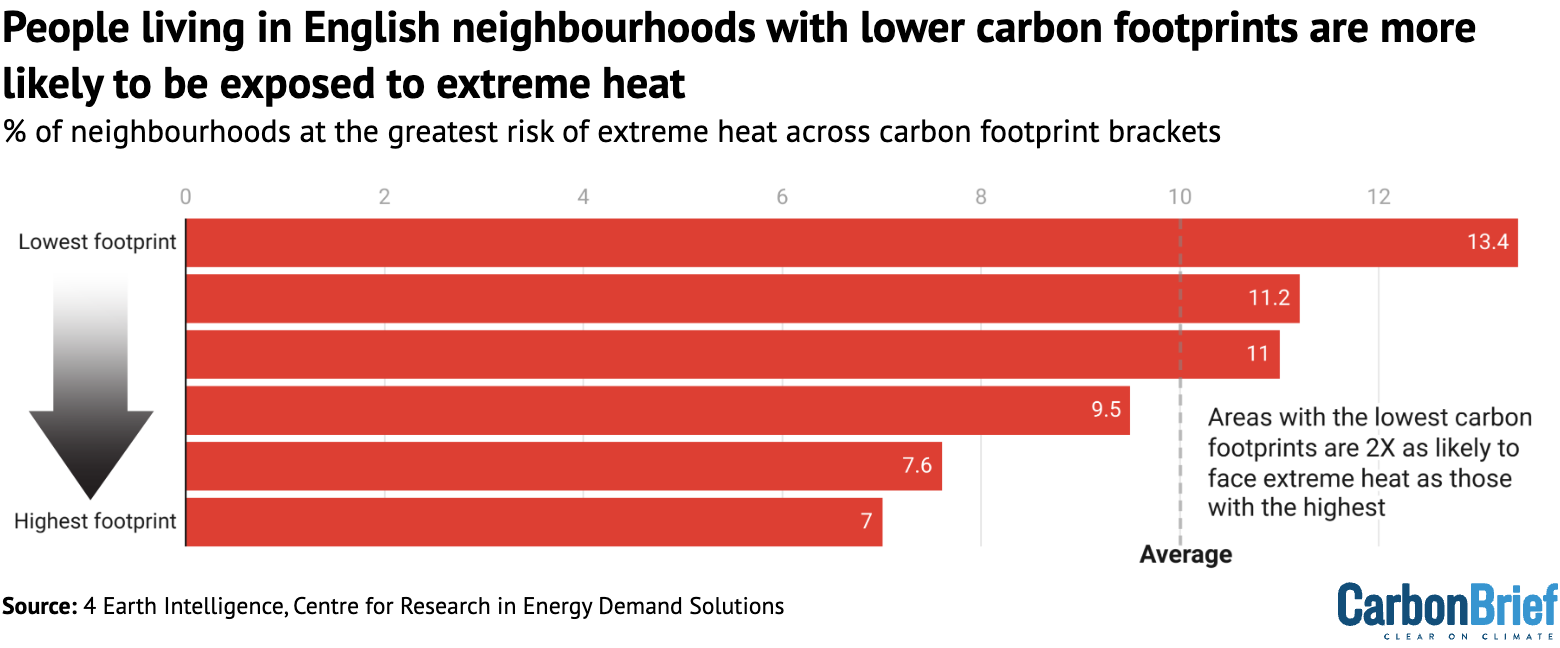
Neighbourhoods in England with lower carbon footprints are often in dense, urban areas, where people tend to be less reliant on cars and more likely to live in energy-efficient flats.
Areas with higher carbon footprints are commonly found in rural areas, where travelling by car can be a necessity due to limited public transport.
Also, particularly in south-east England, people in these rural neighbourhoods are often wealthier, meaning they spend more money on flights and other high-emitting luxuries.
Ethnicity and deprivation
Carbon Brief also analysed the heat threat facing deprived neighbourhoods in England and those that are home to more people of colour.
Information about how many people identify as black, Asian and other minority ethnicities in each neighbourhood is based on 2021 census data, via the Office for National Statistics.
As the chart below shows, there is a clear correlation between the number of people of colour living in a neighbourhood and the likelihood of it facing extreme heat during periods of hot weather.
The most ethnically diverse neighbourhoods – where roughly half or more of the population are people of colour – are 15 times more likely to have high heat hazard scores than the least ethnically diverse neighbourhoods, where almost everyone is white.
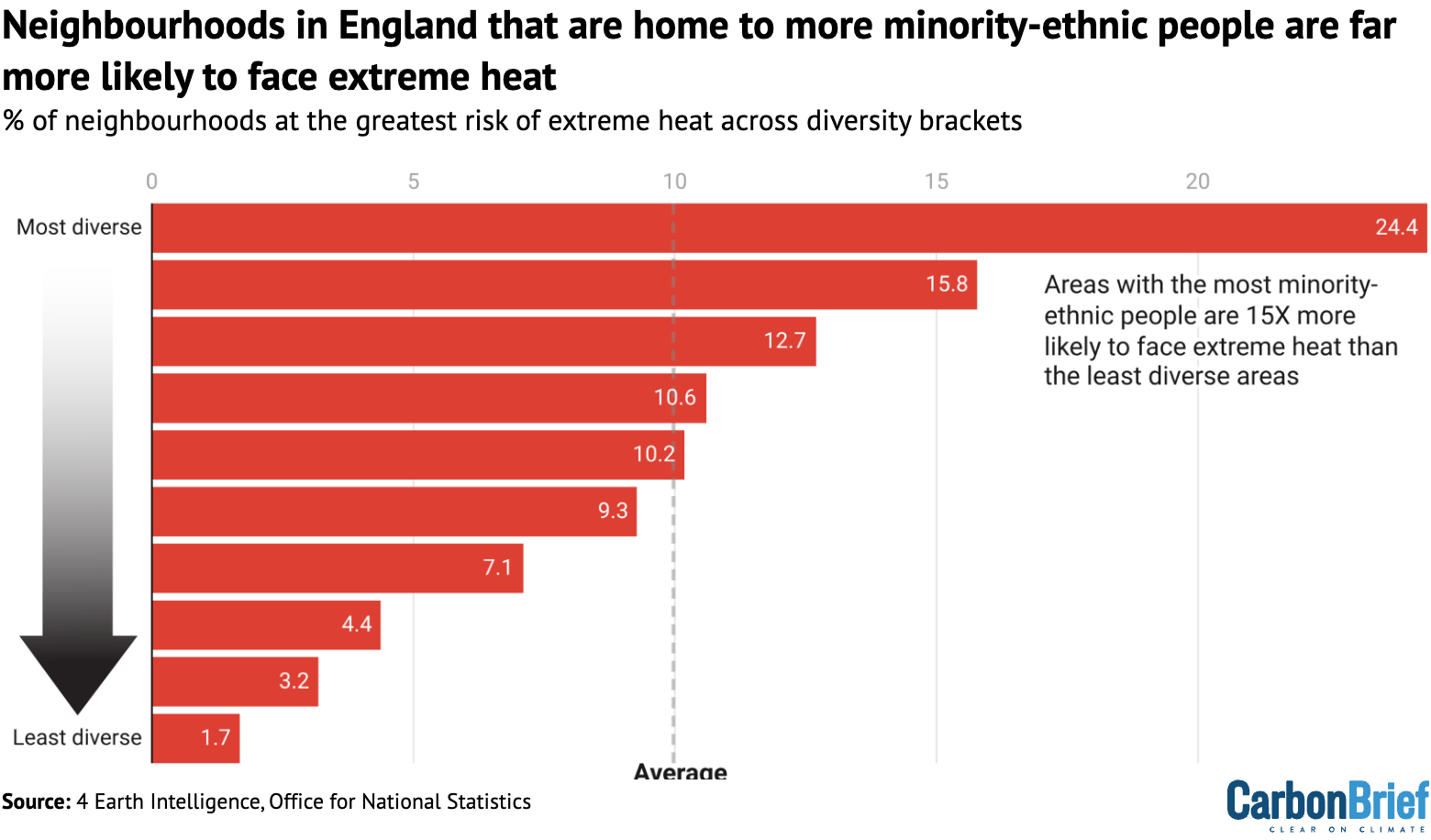
Among the most diverse areas are parts of Newham in east London, Saltley in Birmingham and Spinney Hills in Leicester, all of which are inner-city areas.
The least diverse neighbourhoods range from coastal parts of Redcar and Cleveland in North Yorkshire to the rural villages of south Somerset. None of England’s hottest 1% of neighbourhoods are in this bracket.
Additionally, Carbon Brief assessed the relationship between levels of poverty and heat risk, based on England’s indices of deprivation dataset. This covers several measures of deprivation, including income, employment and health.
People living in the most deprived English neighbourhoods are more than three times as likely to face high levels of heat hazard as those in the least deprived neighbourhoods, as shown in the figure below.
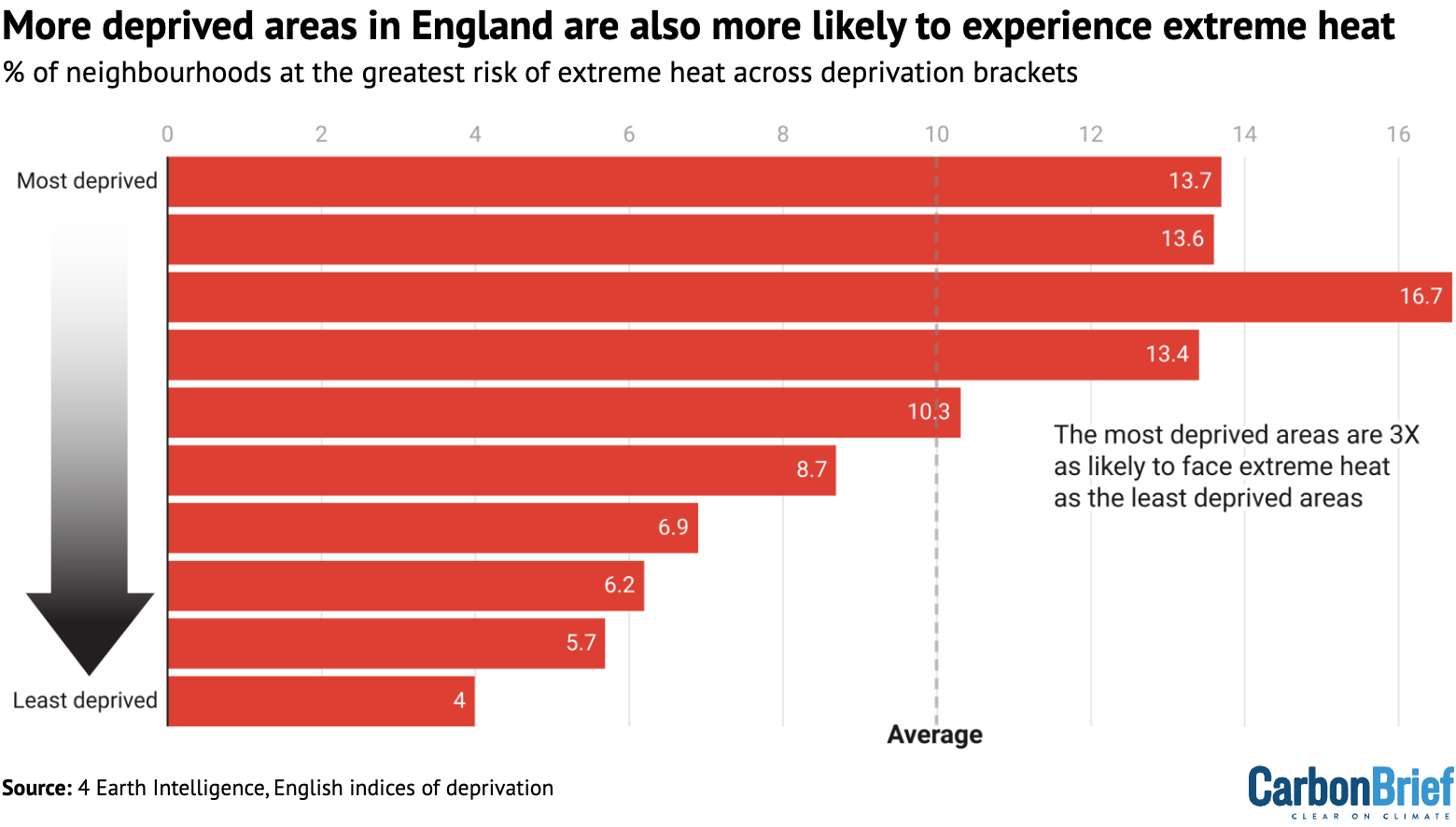
The correlation between poverty and extreme heat is less extreme than the one between heat exposure and ethnicity.
While many of England’s most deprived areas are in cities, they are also clustered in some rural and coastal areas – such as parts of Cornwall and Lincolnshire – which tend to be cooler.
Urban heat island
The key phenomenon captured by this analysis is the urban heat island effect. This describes how cities – and particularly areas with dense buildings, roads and stretches of concrete that absorb heat – tend to be hotter than the surrounding countryside.
Cities such as London, Manchester and Birmingham have reached temperatures up to 5C hotter than the surrounding areas in recent decades, due to this effect.
The diagram below shows how air flows circulate between rural and urban areas, forming “heat domes” over cities.
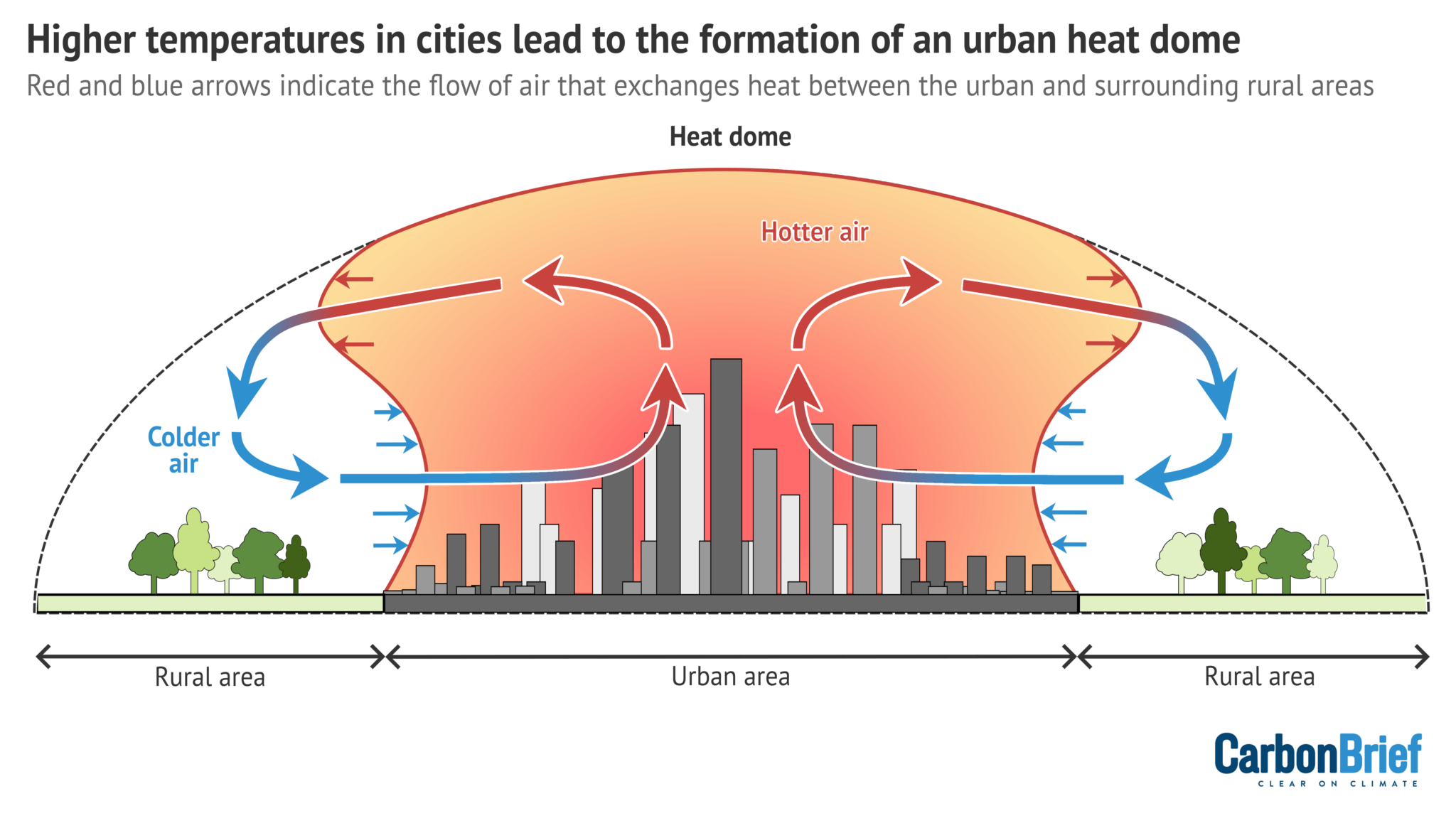
Inner-city areas in England are also home to many people facing high levels of deprivation, as well as large black and Asian communities. Many of these communities are therefore exposed to more dangerous temperatures due to the urban heat island effect.
Access to green spaces, even within cities, also influences exposure to the urban heat island effect. Research has shown how people in deprived areas and people of colour – particularly black people – are more likely to live in areas with less access to green spaces.
There is already extensive scientific literature that uses satellite data to demonstrate the urban heat island effect in cities and other locations.
A number of studies have also used this data to show how people of colour and those living in poverty are more exposed to extreme heat. Much of this research has come from the US, where historic housing inequalities have created stark patterns of segregation in many cities.
A project led by environmental policy researcher Dr Angel Hsu of the University of North Carolina-Chapel Hill shows how, globally, “cities are burdening lower-income populations with higher heat exposure”, as she tells Carbon Brief.
Given this, Hsu adds that “it’s not surprising to us to see similar disproportionate exposure patterns among UK neighbourhoods”.
Other researchers tell Carbon Brief that it is important to be wary of satellite data, as it does not precisely capture the air temperatures experienced in these neighbourhoods.
Dr Charles Simpson, who researches the health and economic impacts of climate change at University College London (UCL), notes:
“Satellite-measured surface temperature does not always correlate with the air temperature – what you are measuring includes a lot of road surfaces and rooftops. The air temperature is thought to be more directly relevant to people’s health and their cooling needs.”
Previous research has found that satellite data can therefore overestimate the urban heat island effect compared to data from weather stations.
These stations, however, are not widespread enough to allow comparisons with detailed neighbourhood data. They are particularly lacking in more deprived areas in England, potentially making measurements there less reliable.
Other scientists tell Carbon Brief that, in the absence of a comprehensive ground monitoring network, satellite measurements can serve as a stand-in to estimate heat exposure. Dr Chloe Brimicombe, an extreme-heat researcher based at the University of Graz, explains:
“Although it’s not a good indicator of perceived [temperature], it is a good indicator of what regions are most built up and have the environments that are most vulnerable to heat.”
‘Amplifying’ inequalities
There is a growing body of evidence gathered by activists, scientists and local governments around the UK revealing the unequal burden of climate change.
Dr Charles Ogunbode, an assistant professor of applied psychology at the University of Nottingham who specialises in how people experience climate change, tells Carbon Brief that this kind of data helps to clarify the links between climate change and inequalities:
“We can’t avoid dealing with the issue of social inequalities and climate change is just basically amplifying those things. It’s highlighting them, it’s revealing them. So whatever policies we put in place – be it in the health sector, be it in the climate sector – addressing those inequalities has to be an essential part of whatever those responses are.”
There are many factors influencing how people experience heat that are not captured in Carbon Brief’s analysis.
Previous work by researchers at the University of Manchester and Friends of the Earth has explored this issue, including an analysis of more than 40 indicators that could make neighbourhoods more “socially vulnerable” to heat.
This reveals similar outcomes, with people of colour and those contributing the least to climate change generally more vulnerable to its impacts.
One of the biggest factors that contributes to people’s exposure to heat extremes in the UK is the country’s housing stock, which is “not fit for the future”, according to the CCC.
UK homes have generally not been built for hotter conditions and poorer people are more likely to live in badly adapted housing. Those living in small homes, flats and social housing in England all “suffer significantly more overheating” during heatwaves, according to one study.
Dr Giorgos Petrou, a researcher in building physics modelling at UCL, tells Carbon Brief that it is also vital to consider whether households have the ability to adapt to climate change. “Amongst other factors, their capability will depend on their financial means and whether they own or rent their home,” he says.
Experts tell Carbon Brief that the government should act across its policy agenda to not only address extreme heat, but also support those who are most affected by it. This could involve expanding tree cover and renovating old social housing stock in at-risk communities.
Emma Howard Boyd, a former chair of the Environment Agency who also chaired the London Climate Resilience Review, tells Carbon Brief:
“I do think that with [the Labour] government focusing on house building and retrofit, this is a fantastic opportunity to get this right…For those communities that have had the least impact on the environment and climate change themselves.”
Methodology
This analysis collates several datasets that cover England at a neighbourhood level, with “neighbourhoods” defined as lower-layer super output areas (LSOAs). These are small statistical areas used by the UK government, covering populations of about 1,500-3,000 people. There are 33,755 LSOAs in England.
Data on vulnerability to heat comes from 4 Earth Intelligence (4EI), which analyses land surface temperature to generate “heat hazard” information at a 30m resolution. This detailed information has been converted into LSOAs by 4EI.
Heat hazard scores are calculated by 4EI, based on the likelihood that a given neighbourhood will experience high temperatures during hot weather, relative to the surrounding area.
Each score corresponds to a different percentile of English neighbourhoods. The bar below shows the percentage breakdown across all LSOAs in England.
The two hottest scores – those coloured in red – correspond to the 10% of English neighbourhoods that have higher heat hazard scores than the remaining 90%.

For simplicity, Carbon Brief’s analysis focuses on the red bars above, meaning neighbourhoods in either the top 90th-99th percentile or 99th percentile of heat hazard. (Neighbourhoods in the 90th-99th percentile have higher heat hazard scores than 90% of areas in England. Neighbourhoods in the 99th percentile have higher heat hazard scores than 99% of areas.)
It shows how these two scores are overrepresented in LSOAs that have lower carbon footprints, more diverse communities and higher levels of deprivation.
Carbon-footprint data is from the CREDS “place-based carbon calculator”, which estimates the average per-person carbon footprint for every LSOA in England. It accounts for emissions-producing activities ranging from electricity use to “consumption of goods and services”.
CREDS assigns the grades “A” to “F” (low carbon footprint to high carbon footprint) to neighbourhoods. Carbon Brief has based its carbon-footprint analysis on these grades.
LSOA-level data on black, Asian and other minority-ethnic populations comes from 2021 census data. English LSOAs were broken down into deciles, based on the percentage of the population that identified as non-white ethnicities.
The lowest decile covered the tenth of LSOAs with between 0 and 2% non-white minority-ethnic populations and the highest covered the tenth with more than 51%.
England’s indices of multiple deprivation dataset also includes LSOA-level information. It provides relative measures of deprivation for LSOAs in England, based on income, employment, education, health, crime, living environment and barriers to housing and services. Carbon Brief broke the LSOAs down into deciles based on the total deprivation scores, from the most deprived to the least deprived.
The post Analysis: England’s most ethnically diverse areas are 15 times more likely to face extreme heat appeared first on Carbon Brief.
Analysis: England’s most ethnically diverse areas are 15 times more likely to face extreme heat
-
Climate Change2 years ago
Spanish-language misinformation on renewable energy spreads online, report shows
-
Climate Change Videos2 years ago
The toxic gas flares fuelling Nigeria’s climate change – BBC News
-

 Greenhouse Gases1 year ago
Greenhouse Gases1 year ago嘉宾来稿:满足中国增长的用电需求 光伏加储能“比新建煤电更实惠”
-

 Climate Change1 year ago
Climate Change1 year ago嘉宾来稿:满足中国增长的用电需求 光伏加储能“比新建煤电更实惠”
-

 Carbon Footprint1 year ago
Carbon Footprint1 year agoUS SEC’s Climate Disclosure Rules Spur Renewed Interest in Carbon Credits
-
Climate Change2 years ago
Why airlines are perfect targets for anti-greenwashing legal action
-
Climate Change Videos2 years ago
The toxic gas flares fuelling Nigeria’s climate change – BBC News
-
Climate Change2 years ago
Some firms unaware of England’s new single-use plastic ban

